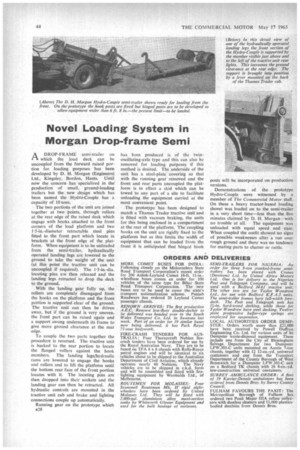Novel Loading System in Morgan Drop-frame Semi
Page 46

If you've noticed an error in this article please click here to report it so we can fix it.
A DROP-FRAME semi-trailer on rl which the load deck can be uncoupled from the forward raised portion for loading purposes has been developed by D. H. Morgan (Engineers) Ltd., Kingsley, Bordon, Hants. Until now the concern has specialized in the production of small, ground-loading trailers but the new design which has been named the Hydto-Couple has a capacity of 10 tonS.
The two portions of the unit are joined together at two points, through rollers at the rear edge of the raised deck which engage with hooks attached to the front corners of the load platform and two 1-5-in.-diameter retractable steel pins fitted to the front part which locate in brackets at the front edge of the platform. When equipment is to be unloaded from the semi-trailer, hydraulically operated landing legs arc lowered to the ground to take the weight of the unit (at this point the tractive unit can be uncoupled if required). The l.5-in.-dia. locating pins are then released and the landing legs retracted to drop the deck to the ground.
With the landing gear fully up, the rollers are completely disengaged from the hooks on the platform and the front portion is supported clear of the ground. The tractive unit can then be driven away, but if the ground is very uneven, the front part can be raised again and a support swung underneath its frame to give more ground clearance at the rear edge.
To couple the two parts together the procedure is reversed. The tractive unit is backed to the rear portion to locate the flanged rollers against the hook members. The landing legs/hydraulic rams are lowered to engage the hooks and rollers and to lift the platform until the bottom rear face of the front portion locates with it. The locating pins are then dropped into their sockets and the landing gear can then be retracted. All hydraulic controls are mounted in the Inactive unit cab and brake and lighting connections couple up automatically.
Running gear on the prototype which a28
has been produced is of the twinoscillating-axle type and this can also be removed for loading purposes if this method is desired. The underside of the unit has a steel-plate covering so that with the running gear removed and the front and rear parts uncoupled the platform is in effect a skid which can be towed to any part of a site to facilitate unloading the equipment carried at the most convenient point.
The prototype has been designed to match a Thames Trader tractive unit and is fitted with vacuum braking, the units for this being enclosed in a compartment at the rear of the platform. The coupling hooks on the unit are rigidly fixed to the platform but as this limits the width of equipment that can be loaded from the front it is anticipated that hinged hook posts will be incorporated on production versions.
Demonstrations of the prototype Hydro-Couple were witnessed by a member of The Commercial Motor staff. On these a heavy tractor-based loading shovel was loaded on to the semi-trailer in a very short time—less than the five minutes claimed by D. H. Morgan--with no trouble at all. The equipment was unloaded with equal speed and ease. When coupled the outfit showed no signs of possible weaknesses after a run over rough ground and there was no tendency for mating parts to chatter or rattle.












































































































